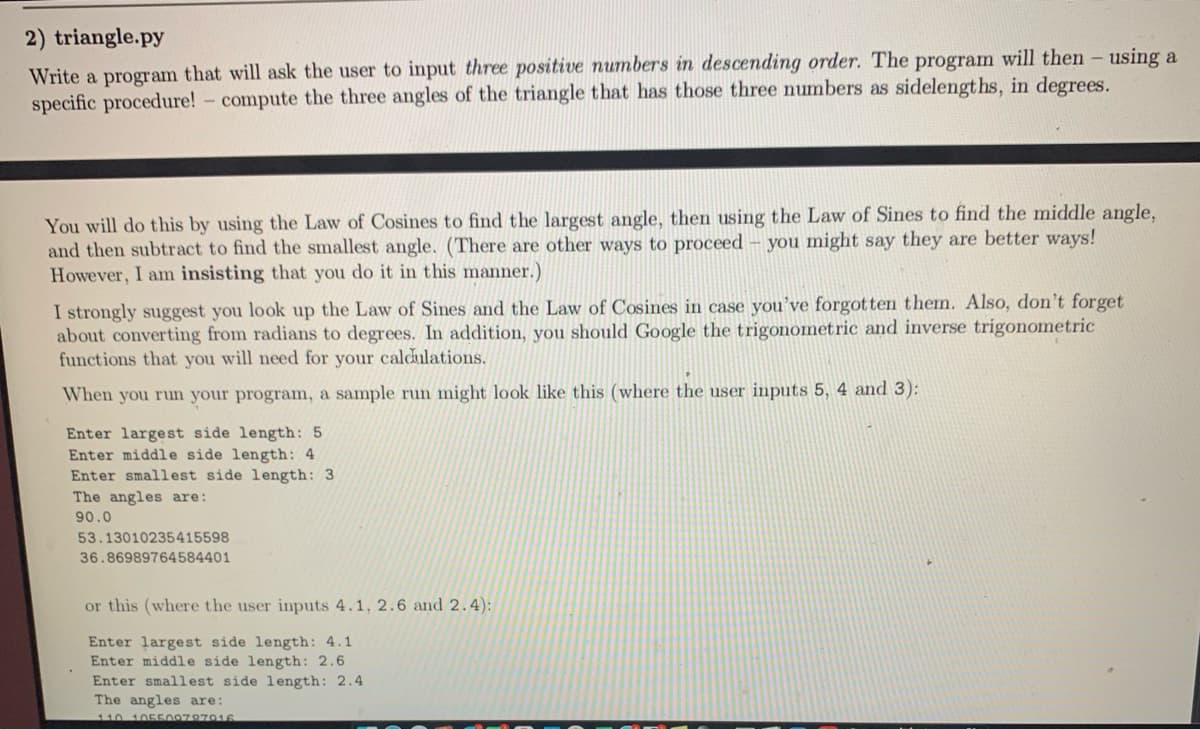2) triangle.py Write a program that will ask the user to input three positive numbers in descending order. The program will then - using a specific procedure! - compute the three angles of the triangle that has those three numbers as sidelengths, in degrees. You will do this by using the Law of Cosines to find the largest angle, then using the Law of Sines to find the middle angle, and then subtract to find the smallest angle. (There are other ways to proceed - you might say they are better ways! However, I am insisting that you do it in this manner.) I strongly suggest you look up the Law of Sines and the Law of Cosines in case you've forgotten them. Also, don't forget about converting from radians to degrees. In addition, you should Google the trigonometric and inverse trigonometric functions that you will need for your caldulations. When you run your program, a sample run might look like this (where the user inputs 5, 4 and 3): Enter largest side length: 5 Enter middle side length: 4 Enter smallest side length: 3 The angles are: 90.0 53.13010235415598 36.86989764584401
2) triangle.py Write a program that will ask the user to input three positive numbers in descending order. The program will then - using a specific procedure! - compute the three angles of the triangle that has those three numbers as sidelengths, in degrees. You will do this by using the Law of Cosines to find the largest angle, then using the Law of Sines to find the middle angle, and then subtract to find the smallest angle. (There are other ways to proceed - you might say they are better ways! However, I am insisting that you do it in this manner.) I strongly suggest you look up the Law of Sines and the Law of Cosines in case you've forgotten them. Also, don't forget about converting from radians to degrees. In addition, you should Google the trigonometric and inverse trigonometric functions that you will need for your caldulations. When you run your program, a sample run might look like this (where the user inputs 5, 4 and 3): Enter largest side length: 5 Enter middle side length: 4 Enter smallest side length: 3 The angles are: 90.0 53.13010235415598 36.86989764584401
C++ Programming: From Problem Analysis to Program Design
8th Edition
ISBN:9781337102087
Author:D. S. Malik
Publisher:D. S. Malik
Chapter5: Control Structures Ii (repetition)
Section: Chapter Questions
Problem 30PE
Related questions
Question
In python

Transcribed Image Text:2) triangle.py
Write a program that will ask the user to input three positive numbers in descending order. The program will then - using a
specific procedure!- compute the three angles of the triangle that has those three numbers as sidelengths, in degrees.
You will do this by using the Law of Cosines to find the largest angle, then using the Law of Sines to find the middle angle,
and then subtract to find the smallest angle. (There are other ways to proceed - you might say they are better ways!
However, I am insisting that you do it in this manner.)
I strongly suggest you look up the Law of Sines and the Law of Cosines in case you've forgotten them. Also, don't forget
about converting from radians to degrees. In addition, you should Google the trigonometric and inverse trigonometric
functions that you will need for your caldulations.
When you run your program, a sample run might look like this (where the user inputs 5, 4 and 3):
Enter largest side length: 5
Enter middle side length: 4
Enter smallest side length: 3
The angles are:
90.0
53.13010235415598
36.86989764584401
or this (where the user inputs 4.1, 2.6 and 2.4):
Enter largest side length: 4.1
Enter middle side length: 2.6
Enter smallest side length: 2.4
The angles are:
110 105500787916
Expert Solution
This question has been solved!
Explore an expertly crafted, step-by-step solution for a thorough understanding of key concepts.
This is a popular solution!
Trending now
This is a popular solution!
Step by step
Solved in 3 steps with 1 images

Knowledge Booster
Learn more about
Need a deep-dive on the concept behind this application? Look no further. Learn more about this topic, computer-science and related others by exploring similar questions and additional content below.Recommended textbooks for you

C++ Programming: From Problem Analysis to Program…
Computer Science
ISBN:
9781337102087
Author:
D. S. Malik
Publisher:
Cengage Learning

C++ for Engineers and Scientists
Computer Science
ISBN:
9781133187844
Author:
Bronson, Gary J.
Publisher:
Course Technology Ptr

C++ Programming: From Problem Analysis to Program…
Computer Science
ISBN:
9781337102087
Author:
D. S. Malik
Publisher:
Cengage Learning

C++ for Engineers and Scientists
Computer Science
ISBN:
9781133187844
Author:
Bronson, Gary J.
Publisher:
Course Technology Ptr